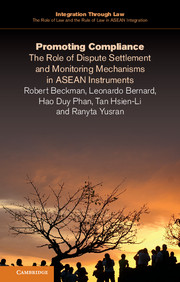Book contents
- Frontmatter
- Contents
- List of figures
- General editors’ preface
- List of abbreviations
- Introduction: overview and research rationale
- 1 The normative and theoretical underpinnings of ASEAN compliance behaviour
- 2 Dispute settlement mechanisms in ASEAN
- 3 Compliance monitoring mechanisms in ASEAN
- 4 Recommendations
- Executive summary
- Appendix 1 CIL’s observation on dispute settlement clauses in selected ASEAN agreements adopted prior to the ASEAN Charter
- Appendix 2 List of ASEAN instruments' provisions related to treaty compliance
- Bibliography
- Index
4 - Recommendations
Published online by Cambridge University Press: 05 March 2016
- Frontmatter
- Contents
- List of figures
- General editors’ preface
- List of abbreviations
- Introduction: overview and research rationale
- 1 The normative and theoretical underpinnings of ASEAN compliance behaviour
- 2 Dispute settlement mechanisms in ASEAN
- 3 Compliance monitoring mechanisms in ASEAN
- 4 Recommendations
- Executive summary
- Appendix 1 CIL’s observation on dispute settlement clauses in selected ASEAN agreements adopted prior to the ASEAN Charter
- Appendix 2 List of ASEAN instruments' provisions related to treaty compliance
- Bibliography
- Index
Summary
Revisiting the question propelling our study – whether dispute settlement mechanisms can improve regional compliance with ASEAN instruments – the answer is: it depends. Dispute settlement mechanisms may give greater credibility to commitments, and the possibility of punitive measures can act as a deterrent against non-compliance. However, as demonstrated in the previous Chapters, both theory and practice in ASEAN show that dispute settlement mechanisms may not compel adherence as effectively as do compliance monitoring mechanisms. Another point to note is that ASEAN dispute settlement mechanisms currently appear not to fulfil their primary function of resolving conflicts. However, recourse to such regional mechanisms cannot be ruled out as ASEAN evolves. Just like it was quite unimaginable for ASEAN member states in a ‘spirit of brotherhood’ to litigate against one another in the past, they are increasingly bringing their contentions before international tribunals for peaceful resolution. In addition, while ASEAN has taken measures to increase compliance monitoring mechanisms, serious lacunae in their substantive functions exist. In sum, the dispute settlement and compliance monitoring mechanisms in ASEAN are presently not very effective – they are simply not being used. This may be because of the practice, entrenched throughout the ASEAN region, that formal dispute settlement should be avoided. Alternatively, structural flaws in the mechanisms could be deterring member states from using them.
As seen in Chapter 1, experts on dispute settlement have suggested that diplomatic engagement yields better results than does litigation, because the adversarial nature of litigation might exacerbate the tense relations in political-security disputes. For instance, the TAC was designed to deal with disputes that threaten the peace and security of the region. From what we have seen of ASEAN member state behaviour, unless disputes escalate to the point of armed conflict, they do not seem to warrant the invocation of the TAC. For example, Singapore avoided recourse to the High Council to resolve its dispute with the Philippines over Flor Contemplacion since it was a bilateral dispute which was nowhere close to affecting regional peace and stability. In the dispute over Sipadan and Ligitan, Malaysia declined Indonesia's suggestion to use the TAC for resolution because, in Malaysia's opinion, the members of the High Council could not be expected to be neutral, since Malaysia had other territorial issues with other ASEAN member states.
- Type
- Chapter
- Information
- Promoting ComplianceThe Role of Dispute Settlement and Monitoring Mechanisms in ASEAN Instruments, pp. 160 - 177Publisher: Cambridge University PressPrint publication year: 2016

